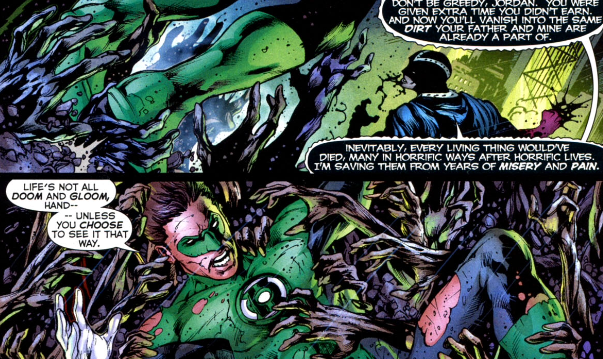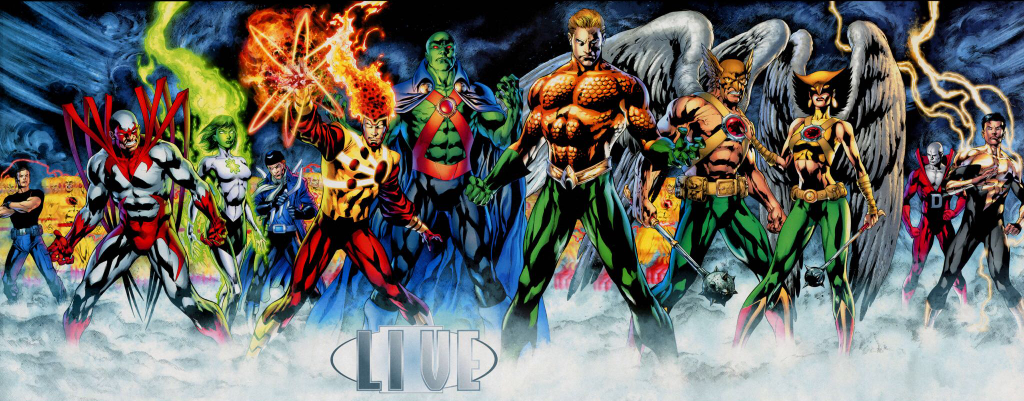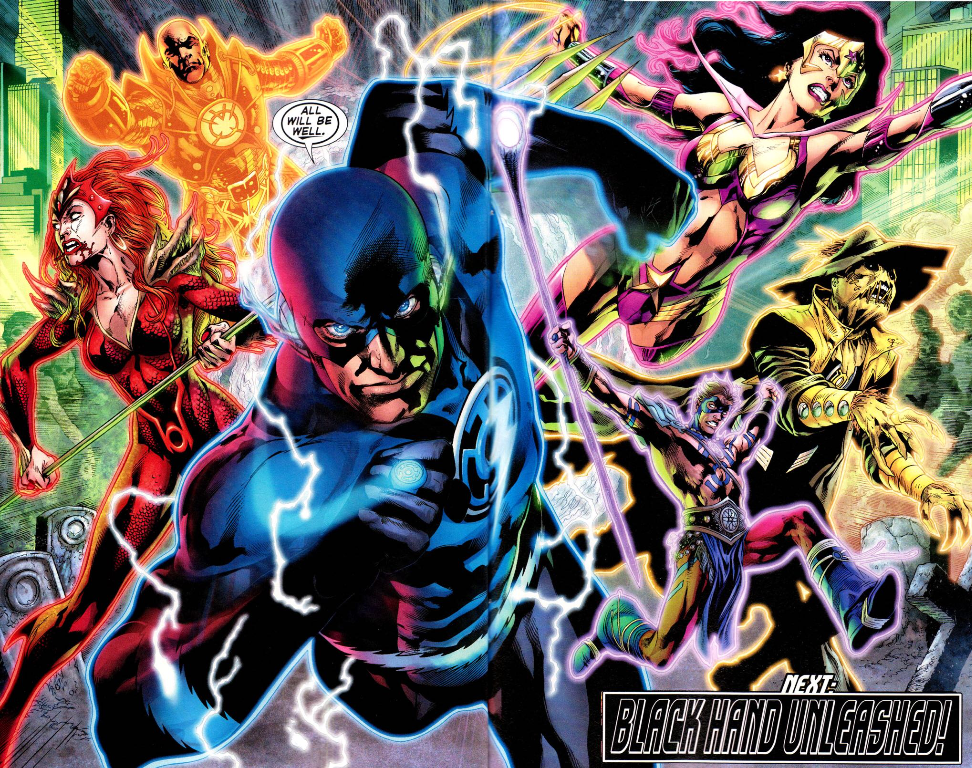
This series of posts reprints 2014 material from my old site, without revision.
DC launched its Blackest Night event in 2009, a time when Geof Johns was the hottest writer around. He’d turned the bottom-selling and usually silly Green Lantern comic into a flagship title that supported its own spin-off book (Green Lantern Corps) and even got a movie green lit.


Blackest Night was also the moment when Johns jumped the shark. He never got better than this. It all started in Green Lantern #43, which the above sequence is from. The event was line-wide, with dozens miniseries and tie-in comics, but this feature will focus on the Blackest Night series itself, occasionally veering off into issues of Green Lantern when they mattered.
The story of Blackest Night was simple: A new force behind a new power ring (black) has the ability to raise the dead, which it does, and tries to take over the universe. There were tons of spin-offs, lots of high drama, and subtle touches like the “Happy Easter” sign above. (Easter: The Holiday for raising the dead.)
In this “free comic book day” giveaway, Geoff Johns explains the entire concept of Blackest Night in a single panel.

There’s a “rise” panel in every issue, and in most of the cross-overs issues too. It’s a bit much. But it adds to the high drama.

The real sense of the stakes here happened at the end of issue #1 of the main series, when they killed Hawkgirl and Hawkman. I remember being shocked.


Of course, if I’d known that just four years later they’d reboot the entire DCU, so none of this mattered, I probably wouldn’t have cared.
It wasn’t all about death though…One of the most memorable and lasting things Blackest Night did was revive Deadman, who hadn’t been much of a player in the 2000s.

Issue #3’s big revelation was…

…There’s a crypt in the Hall of Justice? How…Weird and gross.


Fan favorite Barry Allen was also revived–and enslaved by the Black Hand.

The art was a big part of why this series was so epic. Every issue has several full-page spreads like these.

This stilted dialog wasn’t great, though. Up to now, Geoff Johns been a terrific writer on Action Comics and Teen Titans, among others, but he never wrote anything truly great again.

And now reach the end. And everyone’s invited, including everyone who died….

Yep. The whole thing didn’t even matter! I’m not saying I regret reading this, but I don’t think I’ll be following it into Brightest Day…
Now that it’s over, we can look back over the 8-issue expanse of D.C.’s most recent “event,” Blackest Night, and see how it measures up. First of all, I can easily say, without a doubt, that it’s the best D.C. event ever. Hands down. All of their past Crises (except perhaps Identity Crisis) have been cluttered, unmanageable affairs with a few assets or game-changers. Batman R.I.P. was confusing and required way too much background knowledge for the average reader. Yet Blackest Night, by focusing on the Green Lantern universe but threatening all existence, was at once self-contained and expansive. And, most importantly, it actually had a slam-bang ending. The climax of an event is where even mighty Marvel missteps (Cap surrenders at the end of Civil War?!?), but Geoff Johns’ conclusion—with its reunions and resurrection no-shows–was enough to warm the heart and bring tears to the eyes.
The first three and a half issues had me doubting whether it would be worth reading. It was just a lot of esoteric characters “rising” and other characters dying without any real emotional impact or any sense that they were, in fact, truly dead. The only cross-over miniseries that I read, Superman, Batman, Titans, and Flash, were disposable. As a casual D.C. reader, there wasn’t much for me there. I was in doubt.

But then the series began to gain momentum. I began to notice how brilliant Ivan Reis’ layouts were—I’ve never seen an entire series told in widescreen before. Geoff Johns’ philosophical discussions began to actually have impact—he was done with exposition and was ready to “show not tell.” Green Lantern has always been my least favorite major D.C. hero. The only time I really liked him before Geoff Johns took over the reigns was when Robin handed him his hat in All Star Batman and Robin. And although I liked the return of Hal Jordan, and liked Sinestro War a little more, I still wasn’t loving the character or concepts. Yet I found myself looking forward to each issue of Blackest Night. It became the book I read first each week.
Was it perfect? No. Johns still spends a little too much time on concept and not enough on character, which creates emotional distance between the reader and the action. And Reis can be a little too busy—he’s the student, while George Perez is the master. And I’m not sure I believe that from here on out, dead is dead in the DCU. After all, the next big thing will be the return of Bruce Wayne. (I know, I know, he was never really “dead.”)
And in the final issue, a lot of what we all knew would happen happened. But it still hit me right in the gut. And left me trusting in, and eagerly awaiting, Brightest Day.
